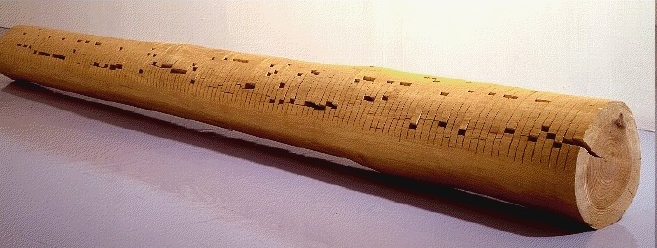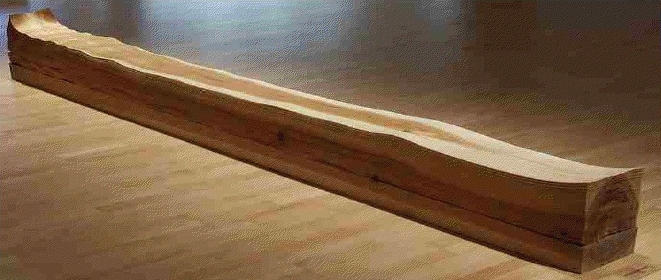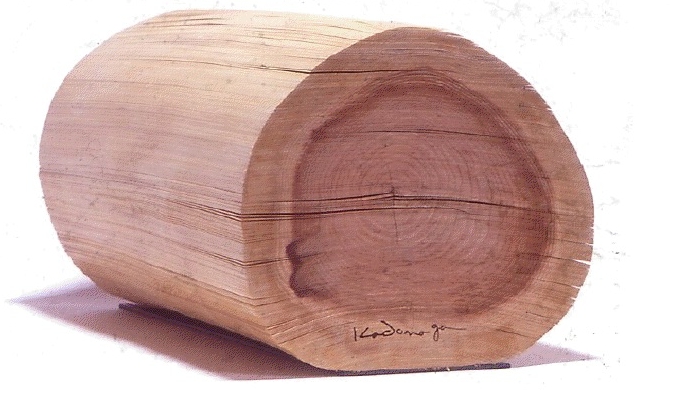| ARTWEEK KAZUO KADONAGA REVERLS NATURE Joan Hugo/ Los Angeles November 21, 1981 |
 |
| Kazuo Kadonaga. "Wood No.8d,” 1977, Wood, 350mm h., at Space gallery, Los Angeles |
Kazuo Kadonaga's work at Space gallery combines a traditionally fastidious attitude about materials with a contemporary conceptualization. His intention, he says, is to reveal nature, both in the traditional Sense of releasing imprisoned forms and in the Japanese sense of respecting natural process. These concerns have found expression as an ongoingseries,
numbered and lettered consecutively and titled, simply Wood.
Each piece in the series offers us the possibility of
admiring qualities such as color and texture, which are intrinsic to the
materials, and also of considering the wood itself as subject matter. A
recent piece, for example, is a large, wall-hung slab a vertical slice
chiseled from a whole log whose polished striations and undulatingmatter. A recent piece, for example, is a large, wall-hung slab − a
vertical slice chiseled from a whole log − whose polished striations and
undulating surface,
suspended horizontally, reveal the tree's naturally occurring torsion. In
another piece, ten thin, partially charred, bark-covered log
can be read, at first, as a minimalist set. But in Japan, apparently, slices
from the blackened, heat-shriveled ends are displayed against white paper and
admired as we would admire dried flowers.
Two small blocks of Hinoki cypress have been
systematically scored and split, one radially, the other on a grid produced by
quartering, then halving each quarter, then quartering each hall. The cuts are
no more than a quarter-inc deep; it is the Splitting that divides the block
into a bundle of uneven sticks. Stacked and laid on its side, the section's
target like pattern of perfect rings, so evenly hatched on one end and so
jaggedly split on the other, reminds us of the wood's own internal order. When
we learn that Kadonaga, (whose family owns a cedar forest and mill in a village
formerly renowned for its samurai, ) used a blade forged from a sword as a tool
for this work, we begin to perceive some of the fastidious attention to the
"rightness" of each detail which we have learned to associate with
the Japanese esthetic tradition. This is even clearer a striking group of work
involving sections or whole trunks of cedar (sugi, that is, cryptomeria, a wood whose use in temples and shrines, some of them
ritually rebuilt from generation to generation, confers on it almost sacred
status in Japan).
 |
| Kazuo Kadonaga. "Wood No.5 A,” 1974, Wood, 3,750mm L., at Space gallery, Los Angeles |
Machine-cut into paper-thin slices, the sect
ions have been reassembled to follow their original contours,
some simply stacked loose, others held together by vegetable
glue or dowels. One piece, a solid-looking trimmed beam,
is actually four hundred separate sheets, glued and heat-pressed
together, two-by-two, to form a whole again. Another,
a sliced, trimmed, free-stacked, one-foot-wide, eighteen-foot
length (which had to be fork-1ifted through the window, since the gallery
is on the second floor) is slowly curling and separating more each day
that it spends in the dry California air. This is the process Kadonaga
wants us to observe; each of these pieces is alive, bowing and warping
in response to each new environment breathing. (After each show,
the work is moistened so that it resumes its original density and profile,
then wrapped in layers of paper and plastic.)
In the
dampness of Japan or Holland, where the work was recently shown, this activity
is less evident; in our climate the change is more radical. It is eminently
visible in another eighteen-foot solid log which has been sliced halfway
through at regular intervals. The rim of each semicircular cut is developing
cracks ranging from a hairline to an inch wide, gaping wider and wider apart
into patterns reminiscent of player piano rolls − patterns governed by the wood's own
reaction to inner tensions and the stress of climate.
 |
| Kazuo Kadonaga. "Wood No.5 G,” 1978, Wood, Space gallery, Los Angeles |
The long, unbroken cultural tradition of Japan has always
maintained a strong contact with the concept of anima mundi, the vital
force. (Since Western culture ruptured that contact centuries ago, our
strongest expressive tradition is the figure.) Kadonaga sees himself as
a facilitator of the continuous revelation of the process of nature. Whether
asking us to admire the honey-colored sheen of cedar, the buttery smoothness
of cypress, the pinwheels of charred wood, the structural processes or
the life cycles of trees themselves, he gives us the means to focus down,
to consider aspects easily overlooked in the hurried, casual way we tend
to view the world.